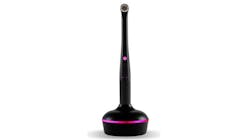I have it—you want it! PinkWave Curing Light
The new technology incorporates UV light, blue and red light, and near infrared (NIR) light to create visible pink light and an outstanding photocure that is both robust and less harmful to the pulp. This powerful light has three settings: 3-second “boost,” 20-second “standard,” and 20-second “ramp.” My preference is the powerful (1720 mW/cm2) 3-second mode for tacking, and most often I rely on the standard (1515 mW/cm2) 20-second mode for curing my restorations. The PinkWave also features a fourth mode of built-in transillumination, which often can confirm interproximal decay and/or microcracks on clinical examination. This is a lightweight, well-balanced, ergonomically designed light with two great features: an on/off button on the top and underside of the light and two stabilizing bumps that prevent the light from rolling off the counter or bracket table. This light has a long battery life and sits upright in a rink-ringed charging stand when not in use. I would agree with their clever marketing slogan: When considering a curing light, “Pink differently!”
More of this column:
I have it—you want it! Ceramir Restore QuikCap
I have it—you want it! Omnichroma Flow & Omnichroma Blocker Flow
I have it—you want it! G2-Bond Universal
Editor's note: This article appeared in the October 2021 print edition of Dental Economics.
Howard Glazer, DDS, FAGD, is a columnist for Dental Economics. He is a key opinion leader in dental products and maintains a general practice in Fort Lee, New Jersey. Dr. Glazer is a fellow and past president of the Academy of General Dentistry (AGD). He lectures frequently on the subjects of dental materials, cosmetic dentistry, forensic dentistry, and patient management.
About the Author

Howard S. Glazer, DDS, FAGD
Howard S. Glazer, DDS, FAGD, is a fellow of the Academy of General Dentistry, American College of Dentists, International College of Dentists, American Society for Dental Aesthetics, American Academy of Forensic Sciences, and a diplomate of the American Board of Aesthetic Dentistry. He is an attending dentist at the Englewood Hospital in Englewood, New Jersey, and the deputy chief forensic dental consultant to the Office of Chief Medical Examiner, City of New York.
